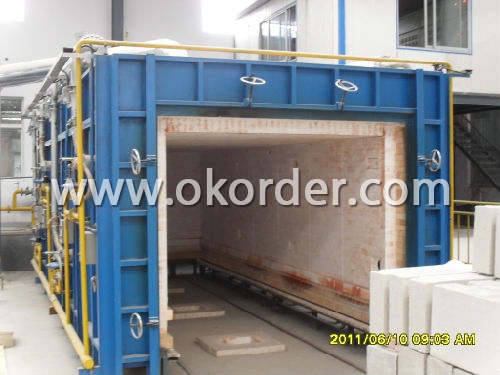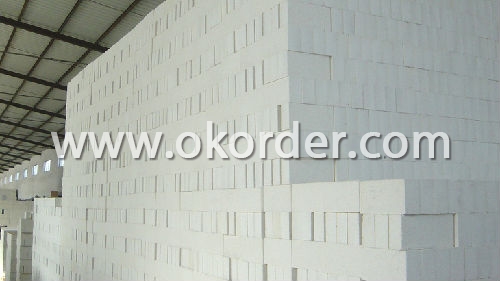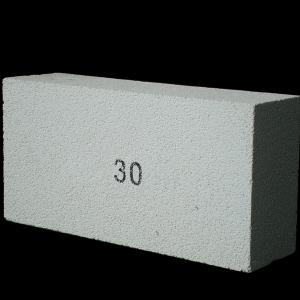Insulating Fire Brick
- Loading Port:
- China Main Port
- Payment Terms:
- TT or L/C
- Min Order Qty:
- 1000 Pcs m.t.
- Supply Capability:
- 1000 Tons Per Month m.t./month
OKorder Service Pledge
OKorder Financial Service
You Might Also Like
General Information of Insulating Fire Brick
Our insulating firebricks are classified under temperature range from 1300℃ to 1700℃.Our insulating fire bricks are manufactured from high purity alumina clay.
Feature of Insulating Fire Brick
Light weight and low thermal conductivity
Low heat storage
Low iron and impurities
High thermal shock resistance
Application of Insulating Fire Brick
Our insulating firebricks can be used as a hot face lining directly exposed to the heat or as a backup insulation layer in iron and steel mills, non-ferrous foundries, petrochemical, ceramic, glass.
Technical Data of of Insulating Fire Brick


- Q:Are insulating fire bricks resistant to erosion?
- Yes, insulating fire bricks are generally resistant to erosion. Insulating fire bricks are made of lightweight materials such as alumina, silica, or a combination of both. These materials have excellent resistance to erosion caused by high temperatures, chemical reactions, and physical wear. They are designed to withstand extreme heat and harsh conditions, making them highly durable against erosion. Additionally, insulating fire bricks have low thermal conductivity, which means that they do not absorb or transfer heat easily, further protecting them from erosion. However, it is important to note that the resistance to erosion may vary depending on the specific composition and quality of the insulating fire bricks.
- Q:Can insulating fire bricks be used for insulation in steam pipes?
- Insulating fire bricks are indeed a viable choice for insulating steam pipes due to their exceptional ability to withstand high temperatures and provide excellent thermal insulation. With their low thermal conductivity, these bricks effectively impede heat transfer, making them perfect for insulating steam pipes. This quality aids in minimizing heat loss and maintaining the steam's temperature within the pipes. Furthermore, the lightweight nature and easy installation of insulating fire bricks make them a convenient option for insulating steam pipes.
- Q:Do insulating fire bricks require any special sealing or caulking?
- Insulating fire bricks generally do not require any special sealing or caulking. These bricks are designed to have low thermal conductivity, which means they already provide good insulation on their own. However, in certain specific applications or when exposed to extreme temperatures, some sealing or caulking may be necessary to ensure optimal performance and prevent any heat loss or damage. It is recommended to consult the manufacturer's guidelines or a professional for specific sealing requirements in such cases.
- Q:Can insulating fire bricks be used in residential applications, such as fireplaces or ovens?
- Residential applications like fireplaces or ovens can indeed utilize insulating fire bricks. These bricks are specifically designed for enduring high temperatures and providing outstanding thermal insulation. They are crafted from lightweight materials like clay or alumina, which possess low thermal conductivity. This attribute assists in retaining the heat within the fireplace or oven, enhancing efficiency and reducing energy consumption. Moreover, insulating fire bricks exhibit exceptional resilience against thermal shock, enabling them to withstand sudden temperature fluctuations without cracking or breaking. Additionally, these bricks are non-combustible, ensuring they can withstand the intense temperatures produced in fireplaces or ovens without posing a fire hazard. Consequently, insulating fire bricks are a suitable option for residential applications requiring high temperatures and thermal insulation.
- Q:How do insulating fire bricks contribute to reducing heat loss?
- The unique thermal properties and design of insulating fire bricks aid in the reduction of heat loss. These bricks are composed of insulating materials, such as ceramic fibers or lightweight refractory aggregates, which possess low thermal conductivity. Consequently, they do not readily conduct heat, preventing the transfer of heat from one side of the brick to the other. Moreover, the structure of insulating fire bricks contains small air pockets or voids within the material. These air pockets function as barriers to heat, as air is a poor conductor of heat. As heat attempts to traverse the brick, it becomes trapped within these voids, significantly diminishing heat transfer. The insulating qualities of these bricks are beneficial in various applications, including industrial furnaces, kilns, and fireplaces. By utilizing insulating fire bricks as lining or insulation material, heat loss from these systems is minimized. This not only helps maintain a more consistent and uniform temperature within the enclosed space but also enhances energy efficiency by reducing wasted heat. Additionally, insulating fire bricks exhibit resistance to high temperatures, ensuring that they do not deteriorate or lose their insulating abilities when exposed to extreme heat. This durability enables them to provide long-lasting insulation and contribute to the reduction of heat loss over an extended period. In conclusion, insulating fire bricks are highly effective in decreasing heat loss due to their low thermal conductivity, presence of air pockets, and resistance to high temperatures. Their integration into various thermal systems aids in conserving energy, enhancing thermal efficiency, and creating a more comfortable and controlled environment.
- Q:Clay insulation bricks insulation, brick and ordinary clay brick, fireclay, brick distinction, and its use? Thank you
- Thermal insulation brick is a new type of energy-saving building insulation technology with inorganic composite material as the main material. It is an ideal technology to replace the traditional wall insulation.
- Q:How do insulating fire bricks help reduce heat loss through convection?
- Insulating fire bricks are specifically designed to minimize heat loss through convection. They achieve this by creating a barrier that prevents the movement of air and heat transfer. These bricks are made from lightweight refractory materials, which have low thermal conductivity. This means that they are not good conductors of heat and do not allow heat to easily pass through them. When these bricks are used in construction, they create a layer of insulation that effectively reduces heat transfer by convection. Convection is the process of heat transfer through the movement of air or fluid particles. The insulating fire bricks act as a barrier, preventing the free flow of air and interrupting the convective currents. The bricks are designed with small, interconnected air pockets or pores, which trap air inside them. These air pockets act as insulators and minimize the transfer of heat by convection. The trapped air forms a stagnant layer, reducing the movement of air and preventing the heat from escaping or entering the area. By reducing heat loss through convection, insulating fire bricks help to maintain a stable and comfortable temperature within a structure. They are commonly used in applications where heat insulation is essential, such as in industrial furnaces, kilns, and fireplaces. These bricks not only enhance energy efficiency by reducing heat loss but also contribute to fire safety by preventing the spread of heat to adjacent areas.
- Q:Can insulating fire bricks be used in the construction of tundishes?
- Yes, insulating fire bricks can be used in the construction of tundishes. Insulating fire bricks are lightweight and have excellent thermal insulation properties, making them ideal for applications where heat retention is important. Tundishes, which are used in the steel industry to control the flow of molten metal, require materials that can withstand high temperatures and minimize heat loss. Insulating fire bricks can withstand the extreme temperatures found in tundishes, helping to maintain the desired temperature of the molten metal and preventing heat loss. Additionally, their lightweight nature makes them easier to handle and install in tundish construction. Overall, insulating fire bricks are a suitable choice for the construction of tundishes due to their thermal insulation properties and ability to withstand high temperatures.
- Q:Are insulating fire bricks resistant to weathering or aging?
- Insulating fire bricks exhibit exceptional resistance to weathering and aging. These bricks are specifically engineered to endure extreme temperatures and harsh environmental conditions. They are composed of top-notch refractory materials, including alumina, silica, and other additives, which confer exceptional thermal insulation properties and strong resistance to corrosion and erosion. The manufacturing process of insulating fire bricks entails meticulous selection of raw materials and precise control of firing temperatures, resulting in a dense and homogeneous structure. This structure effectively prevents moisture and other weathering agents from infiltrating, thus ensuring extended durability and resistance to aging. Moreover, insulating fire bricks are also highly resistant to thermal shock, enabling them to withstand rapid temperature fluctuations without fracturing or disintegrating. This characteristic bolsters their ability to withstand adverse weather conditions. All in all, insulating fire bricks have demonstrated remarkable dependability in diverse applications that involve exposure to weathering elements. They find widespread usage in industries such as steel, ceramic, glass, and cement manufacturing, as well as in high-temperature applications like kilns, furnaces, and chimneys.
- Q:Can insulating fire bricks be used in ceramic fiber blankets?
- No, insulating fire bricks cannot be used in ceramic fiber blankets. Insulating fire bricks are solid and rigid, while ceramic fiber blankets are flexible and designed for insulation purposes. They serve different functions and have different properties, making them incompatible for use together.
1. Manufacturer Overview |
|
|---|---|
| Location | Shandong, China |
| Year Established | 2007 |
| Annual Output Value | Above US$ 5 Million |
| Main Markets | 10.00% Northern Europe 30.00% North America 30.00% Eastern Asia 5.00% Africa 10.00% Southeast Asia 15.00% Western Europe |
| Company Certifications | ISO 9001:2008 |
2. Manufacturer Certificates |
|
|---|---|
| a) Certification Name | |
| Range | |
| Reference | |
| Validity Period | |
3. Manufacturer Capability |
|
|---|---|
| a)Trade Capacity | |
| Nearest Port | Qingdao Port |
| Export Percentage | 90% |
| No.of Employees in Trade Department | 10 |
| Language Spoken: | English; Chinese |
| b)Factory Information | |
| Factory Size: | Above 16,000 square meters |
| No. of Production Lines | Above 3 |
| Contract Manufacturing | OEM Service Offered; Design Service Offered |
| Product Price Range | High; Average |
Send your message to us
Insulating Fire Brick
- Loading Port:
- China Main Port
- Payment Terms:
- TT or L/C
- Min Order Qty:
- 1000 Pcs m.t.
- Supply Capability:
- 1000 Tons Per Month m.t./month
OKorder Service Pledge
OKorder Financial Service
Similar products
New products
Hot products
Related keywords





























